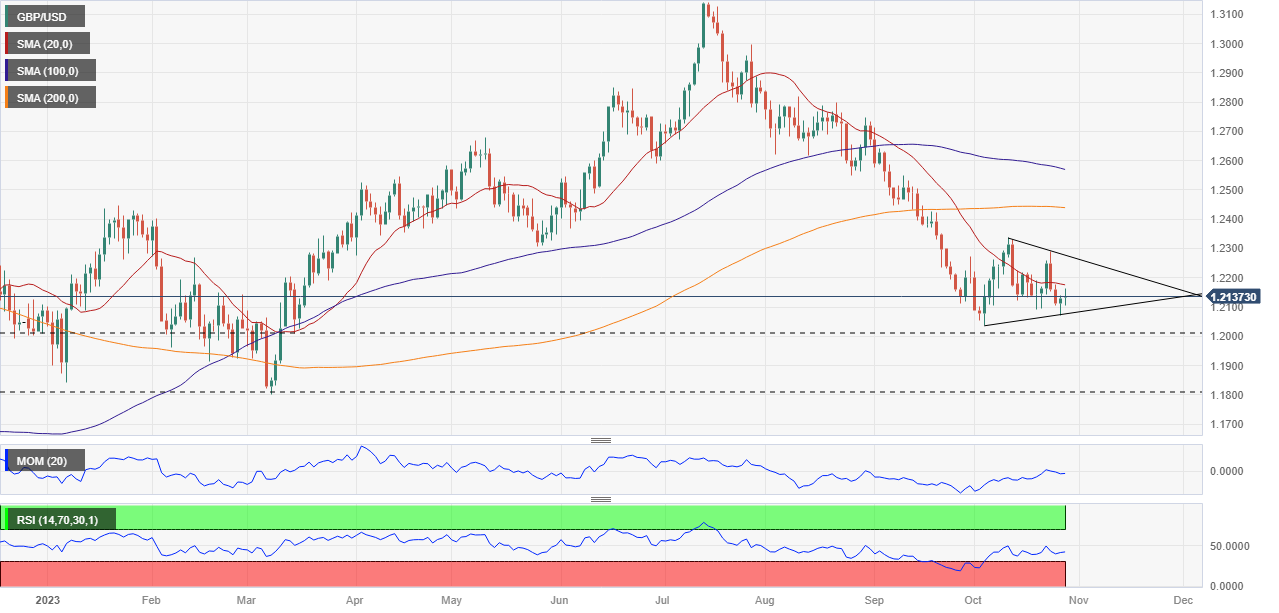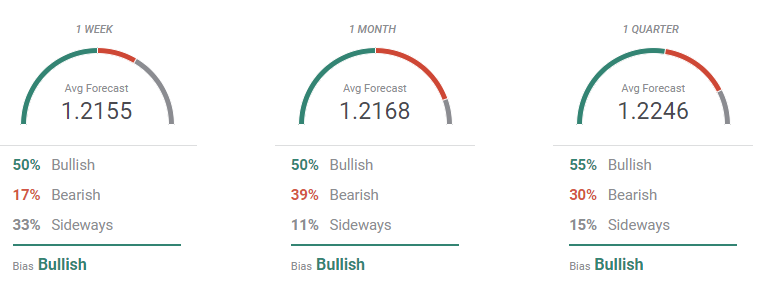- Pound Sterling sellers returned, smashing GBP/USD to a three-week low.
- GBP/USD is set to rock on Federal Reserve and Bank of England policy announcements.
- GBP/USD confirmed a symmetrical triangle breakdown , with a Death Cross in play.
Following a modest uptick a week ago, Pound Sterling returned to the red zone against the United States Dollar (USD), setting a three week low for GBP/USD below the 1.2100 mark. GBP/USD’s short-term technical outlook remains in favor of sellers, as traders look forward to the central banks bonanza week.
GBP/USD: What happened last week?
GBP/USD witnessed good two-way businesses but remained more or less confined in the previous week’s range between 1.2300 and 1.2050. The major continued to remain at the mercy of the US Dollar dynamics, the bond market action and geopolitical developments, concerning the Hamas-Israel conflict.
The Pound Sterling kicked off the week on the right footing, as the US Dollar succumbed to the return of risk flows. Some conciliatory news over the week on the Middle East conflict lifted the overall market mood. Hamas released two US hostages and aid entered through Egypt’s border with Gaza.
The bond market rout resumed Monday, as the benchmark 10-year US Treasury bond yields briefly topped the key 5.0% level for the first time in 16 years. However, a sharp pullback soon ensued in the US Treasury bond yields across the curve, exacerbating the pain in the US Dollar while lifting GBP/USD back to near 1.2250.
The GBP/USD rebound extended on Tuesday, as the pair hit a fresh eight-day high of 1.2289 after markets breathed a sigh of relief on mounting pressure from the US and its allies to reconsider the scope of a ground invasion of Gaza that had been expected any day. Further, investors remained hopeful of upbeat earnings reports from the US tech giants - Apple Inc., Microsoft, Alphabet Inc., Amazon.com Inc. and Nvidia Corp.
Although the upswing remained short-lived on resurgent safe-haven demand for the US Dollar. Industry experts noted that surging Oil prices, renewed geopolitical tensions and the US Federal Reserve’s (Fed) view of higher interest rates for longer pose a threat to the global economic outlook, reviving a flight to safety in the US bonds and the Greenback.
The pair witnessed a midweek crisis, as the pullback from multi-day highs extended, as the US Dollar staged a solid recovery on the back of the ongoing upsurge in the US Treasury bond yields. Strong US S&P Global Manufacturing and Services PMI data and solid earnings results further aided the US Dollar turnaround. S&P Global said on Wednesday, its preliminary US Composite Purchasing Managers Index tracking both the manufacturing and service sectors rose to 51.0 in October, registering the highest level since July this year.
On Thursday, Pound Sterling touched the lowest level in three weeks against the US Dollar at 1.2070 before rebounding sharply to recapture the 1.2100 level. Initially, GBP/USD tumbled on extended US Dollar recovery amid a typical risk-off market environment. Global stocks tanked on a disappointing US tech earnings report from Google parent Alphabet Inc.
Investors also flocked to safety in Gold price and the US Dollar, as the US Treasury bond yields resumed their upward trajectory, with the benchmark 10-year bond yield closing in on 5.0% once again. But the US Dollar failed to hold on to its upside, as the US Treasury bond yields reversed course, despite stronger-than-expected US Gross Domestic Product (GDP) data for the third quarter.
The US GDP rose at a 4.9% annualized pace in the third quarter, ahead of the 4.2% estimate. “The sharp increase came due to contributions from consumer spending, increased inventories, exports, residential investment and government spending,” per CNBC News.
GBP/USD held onto Thursday’s recovery gains, as investors weighed lingering Middle East concerns and upbeat Amazon.com Inc earnings ahead of the US Core Personal Consumption Expenditures (PCE) - Price Index, the Fed’s preferred inflation measure.
On Friday, GBP/USD found demand on encouraging news. On the one hand, the US Personal Consumption Expenditures (PCE) Price Index, was up 3.4% YoY, while the core PCE index, Fed’s favorite inflation measure, rose 3.7%, easing from the previous 3.8%. On a monthly basis, however, the PCE Price Index and the Core PCE Price Index increased 0.4% and 0.3%, respectively. Additionally, markets welcomed headlines indicating progress in negotiations about a ceasefire between Israel and Hamas, mediated by Qatar.
Fed and BoE interest rate decisions in focus
It’s a busy week, filled with major central banking policy meetings, including the all-important Fed and BoE interest rate decision. The Fed policy announcement is due on Wednesday and is expected to make no changes to the Fed funds rates, leaving them at the target range of 5.25%-5.50%. As a Fed pause is almost fully baked in, the focus will be on Fed Chair Jerome Powell’s signals on the path forward on interest rates. A hawish pause, in light of the US economic resilience, is likely to bode well for the US Dollar at the expense of the Pound Sterling.
On the day of the Fed announcement, GBP/USD traders will also be taking trading impetus from the US ADP Employment Change, ISM Manufacturing PMI and JOLTS Job Openings data.
Meanwhile, on Thursday, the BoE could also follow the Fed’s footsteps and keep the interest rate on hold at 5.25%. However, the British central bank’s guidance on rates and the updated quarterly economic forecasts will closely be scrutinized amid growing recession risks.
Friday will feature the critical Nonfarm Payrolls data from the United States, followed by the ISM Services PMI, which will wrap up an eventful week for GBP/USD markets.
In the first half of the week, only the Chinese official Manufacturing and Non-Manufacturing PMI data could be of note on Tuesday, impacting risk sentiment significantly.

GBP/USD: Technical outlook

From a short-term technical perspective, downside risks remain intact for the GBP/USD pair so long as it holds below the critical 21-day Simple Moving Average (SMA) at 1.2177.
The Death Cross and Bear Pennant validated a week ago continue to reinforce selling interest around the Pound Sterling. The pair needs a weekly closing below the rising trendline support at 1.2122 to confirm a downside break from a three-week-long symmetrical triangle.
If a breakdown occurs, the seven-month low of 1.2037 will be the immediate line of defense for Pound Sterling buyers. The next downside target could be the 1.1900 round level should the selling momentum accelerate. Deeper declines could put the focus back on the March low of 1.1803.
On the upside, a sustained break above the 21-day SMA of 1.2122 could initiate a meaningful recovery toward the 1.2335 static resistance. The descending 50-day SMA aligns at that level, making it a powerful supply zone.
Pound Sterling optimists would then aim for the horizontal 200-day SMA at 1.2440.
GBP/USD sentiment poll
The FXStreet Forecast Poll shows the GBP/USD pair could recover some ground in the upcoming weeks as bulls dominate the three time frames under study. Bulls, however, are around 50% in all cases, with a good bunch of experts betting on no changes in the weekly view. GBP/USD is seen between 1.2100 and 1.2200 on average in the near term, while the average for the quarterly perspective increases modestly to 1.2246.
The Overview chart reflects the absence of directional definitions, as the three moving averages had turned flat. Still, it is worth noting that in the monthly and quarterly views, the widest accumulation of possible targets is above the current level, somehow limiting the GBP/USD bearish side.

Information on these pages contains forward-looking statements that involve risks and uncertainties. Markets and instruments profiled on this page are for informational purposes only and should not in any way come across as a recommendation to buy or sell in these assets. You should do your own thorough research before making any investment decisions. FXStreet does not in any way guarantee that this information is free from mistakes, errors, or material misstatements. It also does not guarantee that this information is of a timely nature. Investing in Open Markets involves a great deal of risk, including the loss of all or a portion of your investment, as well as emotional distress. All risks, losses and costs associated with investing, including total loss of principal, are your responsibility. The views and opinions expressed in this article are those of the authors and do not necessarily reflect the official policy or position of FXStreet nor its advertisers. The author will not be held responsible for information that is found at the end of links posted on this page.
If not otherwise explicitly mentioned in the body of the article, at the time of writing, the author has no position in any stock mentioned in this article and no business relationship with any company mentioned. The author has not received compensation for writing this article, other than from FXStreet.
FXStreet and the author do not provide personalized recommendations. The author makes no representations as to the accuracy, completeness, or suitability of this information. FXStreet and the author will not be liable for any errors, omissions or any losses, injuries or damages arising from this information and its display or use. Errors and omissions excepted.
The author and FXStreet are not registered investment advisors and nothing in this article is intended to be investment advice.
Recommended Content
Editors’ Picks

EUR/USD extends slide toward 1.1000 on broad USD strength
EUR/USD stays under bearish pressure and trades at a fresh multi-week low below 1.1050 on Thursday. The upbeat ISM Services PMI data for September boosts the US Dollar, while rising bets for an ECB rate cut in October undermine the Euro.

GBP/USD tests multi-week lows near 1.3100 after Bailey's dovish remarks
GBP/USD loses more than 1% and trades at around 1.3100, pressured by dovish comments from BoE Governor Andrew Bailey, who said that the central bank could become 'more activist' on rate cuts if inflation eases. On the other hand, the USD benefits from strong PMI data.

Gold struggles to gain traction, trades below $2,650
Gold oscillates in a tight range below $2,650 after bets fade that the Fed will continue slashing interest rates aggressively. Although XAU/USD finds support from increasing geopolitical risks, the broad USD strength doesn't allow the pair to stage a rebound.

Bitcoin stabilizes at crucial support after major crash
Bitcoin (BTC) trades slightly down on Thursday, after declining over 7% this week, and holds near a crucial support level; a sustained close below this threshold could signal further declines ahead.

RBA widely expected to keep key interest rate unchanged amid persisting price pressures
The Reserve Bank of Australia is likely to continue bucking the trend adopted by major central banks of the dovish policy pivot, opting to maintain the policy for the seventh consecutive meeting on Tuesday.

Five best Forex brokers in 2024
VERIFIED Choosing the best Forex broker in 2024 requires careful consideration of certain essential factors. With the wide array of options available, it is crucial to find a broker that aligns with your trading style, experience level, and financial goals.